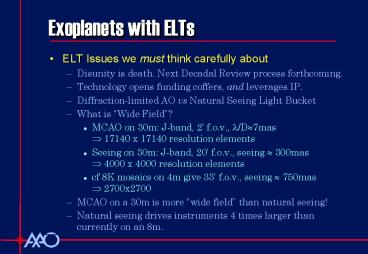Exoplanets with ELTs PowerPoint PPT Presentation
1 / 12
Title: Exoplanets with ELTs
1
Exoplanets with ELTs
- ELT Issues we must think carefully about
- Disunity is death. Next Decadal Review process
forthcoming. - Technology opens funding coffers, and leverages
IP. - Diffraction-limited AO vs Natural Seeing Light
Bucket - What is Wide Field?
- MCAO on 30m J-band, 2 f.o.v., ?/D?7mas? 17140
x 17140 resolution elements - Seeing on 30m J-band, 20 f.o.v., seeing ?
300mas? 4000 x 4000 resolution elements - cf 8K mosaics on 4m give 33 f.o.v., seeing ?
750mas ? 2700x2700 - MCAO on a 30m is more wide field than natural
seeing! - Natural seeing drives instruments 4 times larger
than currently on an 8m.
2
Exoplanets
- Wow factor science (in order)
- 1) Evidence for biological activity on planets
around other stars - Detection of bio-markers from spectroscopy
(terrestrial, gas giants or satellites) - 2) Potentially life-supporting terrestrial
planet(s) around other stars - Detection of terrestrial planets in habitable
zones (NIR imaging orbits) - 3) Detailed understanding of a multiplicity of
terrestrial and gas giant planetary systems. - Detection and orbits for many gas giant and
terrestrial planets - not necessarily habitable
(NIR imaging orbits, NIR spectroscopy, MIR
imaging of young forming systems) - 4) Detailed understanding of a multiplicity of
gas giant planetary systems. - Detection and orbits for many gas giants (as
above).
3
Exoplanets
- 5) Detection and characterisation of young
planetary systems and disks. (this is easier
as they are brighter) - (NIR imaging orbits, NIR spectroscopy, MIR
imaging of young forming systems) - 6) Detection and characterisation of free
floating planets in star forming regions - (NIR imaging orbits, NIR spectroscopy)
4
Exoplanets
- Indirect detection
- Radial velocities (figure in CELT,Magellan and
VLOT cases!) - 3m/s or better ?R ?50-100K. Time sampling.
S/N/pix?300. Vgt8 (targets gtgt sky)? Light
Bucket
5
Single Mirror 30m Light Buckets.
- Bright targets ? Sky brightness irrelevant ?
small slits only needed to control spectrograph
size deliver high resolution. - All the money spent on making a 30m telescope
deliver 0.3 images is a waste. All you need is a
3 image and an image slicer. - eg. an array of 225 x 1m telescopes fibre feeding
spectrograph can deliver photons at high res at
fraction of cost (A15m) of a 0.3 image quality
15m telescope (A200m). - but this is a separate discussion for a separate
facility .
6
Exoplanets
- Indirect detection
- Radial velocities (figure in CELT,Magellan and
VLOT cases!) - 3m/s or better ?R ?50-100K. Time sampling.
S/N/pix?300. Vgt8 (targets gtgt sky)? Light
Bucket? not science for the envisaged 30m
telescopes. - Transit Detection
- Discovery needs wide fields of view ( 106 stars)
GCs with AO? - Follow-up needs objects bright enough for
spectroscopy. ? better done with space based
satellites. - Reflected / Scattered light from known exo-planet
systems - ? Light Bucket
- Astrometry 7mas resolution should do lt700µas
astrometry making some astrometric wobble work
feasible.
7
Direct Resolution / Detection
- In exoplanet science, all the 30m action is in
resolving systems, getting rid of as much parent
starlight as possible, and studying the planets. - Key issues
- Resolution
- Magnitude difference parent starlight
suppression - Sticking light from a coronagraph down a
spectrograph
8
Resolution
100 known exoplanetsApril 2003
- 1-5 of FGK have exoplanets _at_ lt 3au
- More to come?
- Have to go out to 50pc (not 10pc)
- Jupiter _at_ 100mas
- Earth _at_ 20mas
9
Resolution
- AO Coronagraphsgt 4?/D for Sgt0.8(Sivaramakrishna
n et al. ApJ, 552, 397, 2001) - 30m ? gt30mas
- 30 known gas giants resolvable
- Resolve Jupiters to 166pc.
- Resolve Earths to 33 pc
Log10 Periastron Apastron (mas)
100 known exoplanetsApril 2003
10
Magnitude difference
- Signal ? Dtel2 (S A d2 ?) / (D2 r2)Dtel is
telescope diameter, S is Strehl, A is albedo, d
is planet diameter, ? is phase function,
rorbital radius, D is distance of system - Noise ? aimage Dtel2 (1-S) ( s/(?2s/2)2
C)0.5aimage is solid angle of image (?/Dtel)2 ?
N independent of Dtel, s is seeing FWHM, ?r/D,
s/(?2s/2)2 is AO halo profile - Sensitivity scales as Dtel2. 30m is 15x more
sensitive than 8m and 225x faster
11
Seeing exoplanets - with OWL ...
- Gas giants accessible to 30m out to 50pc
- Detect. Orbits. Albedos. Spectroscopy?
12
The Killer Applications
- Detect Gas Giants.Measure Orbits Understand
migration.Albedos for more than 4 gas giants. - NIR Spectroscopy from the coronograph
- Young planets make problem 103 easier.
- Terrestrial planets probably not feasible.
- CELT Green Book project to find terrestrial
planets via rv around M-dwarfs really not
brilliant. - MIR Imager to probe young disks at 70mas at 10um
at 125pc ? 9au - or debris disks about nearer objects?

